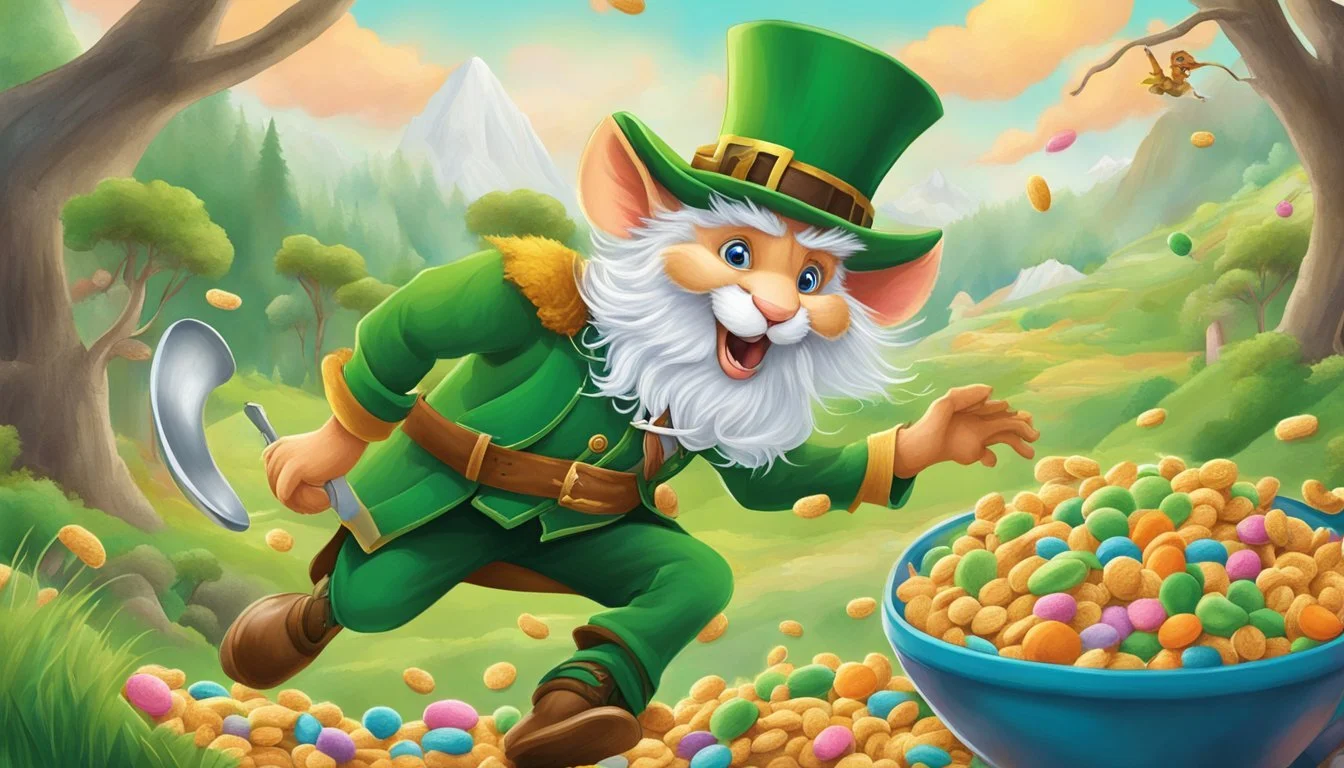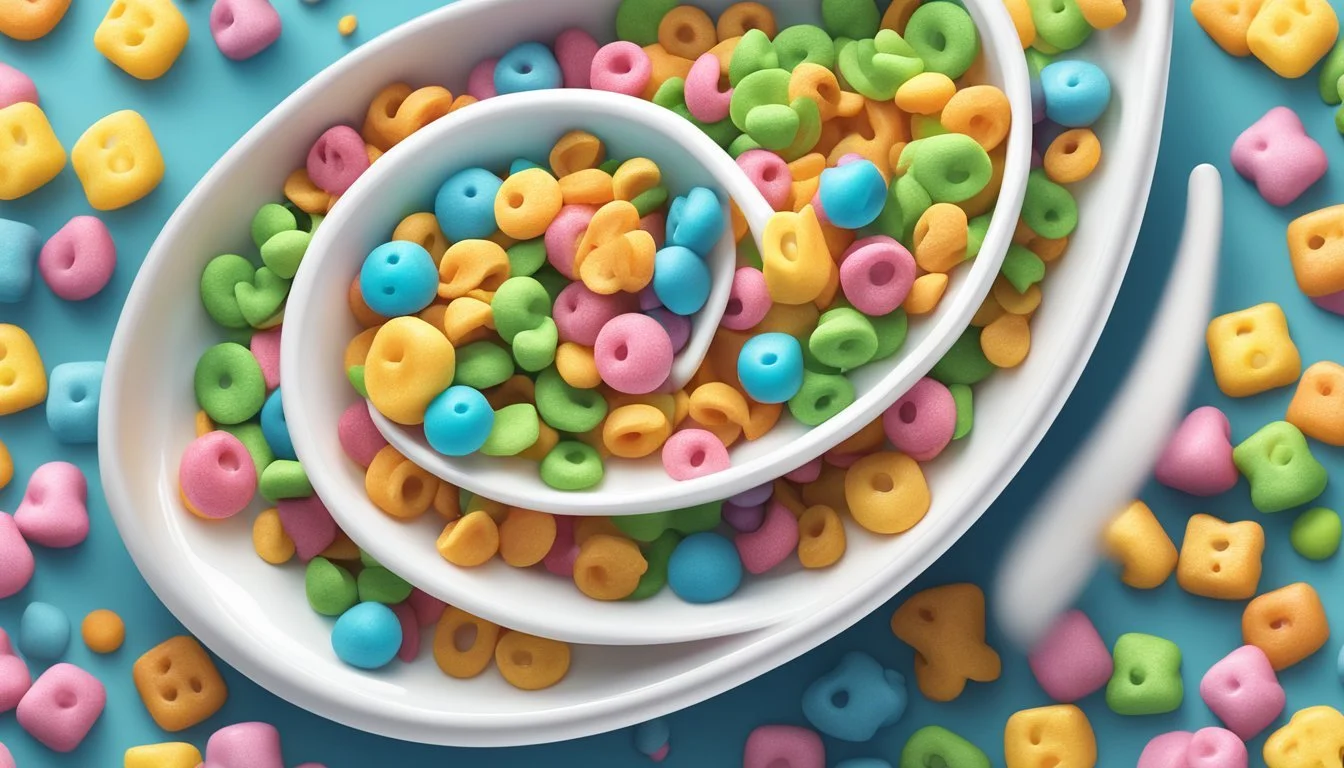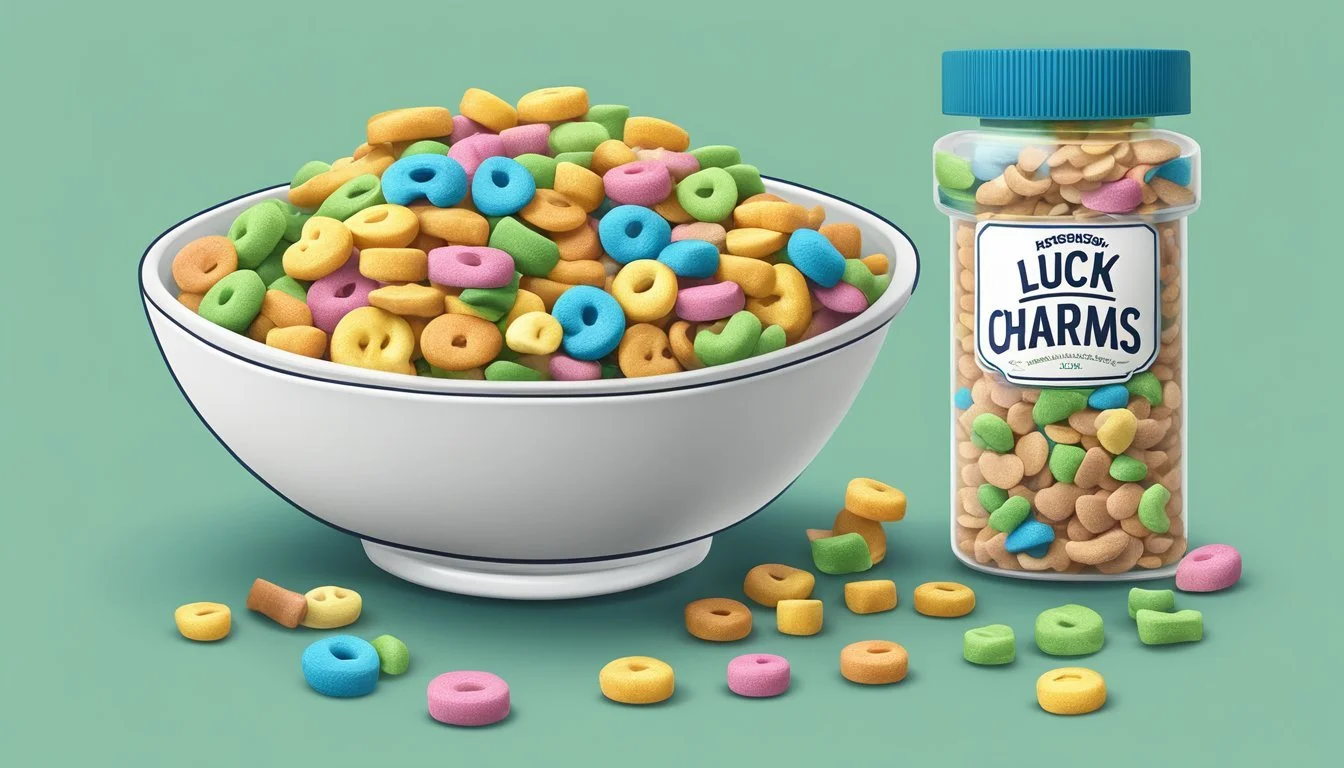Lucky Charms vs Trix
Comparing Nutritional Value and Flavor
This Article is Part of Our Breakfast Cereal Guide with Details on Lucky Charms Nutrition and Trix Nutrition
When choosing between Lucky Charms and Trix, cereal lovers often wonder which option offers a healthier start to the day. Lucky Charms, famous for its colorful marshmallow shapes, is not only a nostalgic favorite but also enriched with vitamins and minerals. Trix, the vibrant fruit-flavored cereal, presents a playful option that many find hard to resist.
Both Lucky Charms and Trix are fortified with essential nutrients, but Lucky Charms typically contain more vitamins and minerals per serving. Ingredients play a key role in the healthiness of these cereals: Lucky Charms incorporate whole grains which provide more fiber, while Trix's bright colors come from artificial dyes.
Ultimately, each cereal carries its unique appeal and nutritional profile, making it important for consumers to weigh their priorities between flavor, childhood memories, and nutritional content when making their choice. With this guide, the differences are clearer, helping to make an informed decision.
History and Development
Lucky Charms and Trix are iconic cereals developed by General Mills. Both have unique beginnings and have undergone various changes over the decades that reflect consumers' evolving tastes and preferences.
Origins of Lucky Charms
Lucky Charms was introduced in 1964 by General Mills.
John Holahan, a product developer, conceived the cereal. He combined Cheerios with colorful marshmallow bits, known as "marbits." This innovative mix was inspired by a grocery store trip.
The inclusion of the playful Leprechaun mascot, Lucky, has been central to its brand identity. Featuring various marshmallow shapes representing charms, the cereal rapidly gained popularity among children.
Over time, the flavors and shapes of the marshmallows have evolved. The core cereal pieces are made from made whole grain oats, while the marshmallow pieces are the standout feature.
Evolution of Trix
Trix, also a General Mills product, was launched in 1954. It initially featured fruit-shaped, multi-colored cereal pieces.
The introduction of the Trix Rabbit character in 1959 marked a pivotal marketing strategy. The Rabbit's famous catchphrase, "Silly rabbit, Trix are for kids!" became ingrained in popular culture.
Through the 1980s and 1990s, Trix underwent several modifications. In 1991, it started using natural fruit flavors. In more recent years, a retro version reintroduced bright, artificially flavored shapes that resonated with nostalgic consumers.
Trix consistently emphasizes vibrant colors and fruity flavors, maintaining its appeal among younger audiences.
Nutritional Comparison
When comparing Lucky Charms and Trix cereals, it's essential to look at various nutritional aspects such as caloric content, macronutrients, and vitamin and mineral fortification. This analysis helps consumers make informed decisions based on their dietary needs.
Caloric Content Analysis
Lucky Charms and Trix have comparable caloric content per serving. According to recent data, Lucky Charms provides around 110 calories per 1 cup serving, while Trix offers a similar amount of approximately 120 calories per serving.
These values are based on the standard serving sizes as defined by General Mills and align with FDA guidelines. Both cereals fall within an expected range for breakfast cereals in terms of calories.
Sugar, Fat, and Protein Content
Lucky Charms: 12 grams per serving
Trix: 13 grams per serving
Fat:
Lucky Charms: 1 gram of total fat per serving
Trix: 1.5 grams of total fat per serving
Lucky Charms: 2 grams of protein per serving
Trix: 1 gram of protein per serving
Lucky Charms generally have slightly lower sugar and fat content compared to Trix. However, it contains more protein, which can be a beneficial aspect for some dietary considerations.
Vitamin and Mineral Fortification
Lucky Charms and Trix both offer an array of fortified vitamins and minerals. Lucky Charms is particularly rich in Folate, providing 92% of the daily recommended intake. Additionally, it offers higher levels of Vitamin B12, Iron, Vitamin B6, Zinc, Vitamin B3, Vitamin A RAE, Selenium, and Phosphorus.
In contrast, Trix primarily stands out in its Vitamin B2 content, which is higher compared to Lucky Charms. Both cereals are fortified to enhance nutritional value, catering to various dietary needs and ensuring a balanced intake of essential micronutrients.
Ingredient Profile
Lucky Charms and Trix vary significantly in their ingredient composition, specifically in their choice of grains and the types of additives and preservatives used.
Cereal Grains Used
Lucky Charms primarily uses whole grain oats, making it distinct among cereals. This gives it a slightly healthier profile due to the nutritional benefits of oats.
Trix, on the other hand, predominantly uses whole grain corn and incorporates rice flour. Both cereals avoid wheat-based ingredients, making them suitable for gluten-free diets.
These grain choices affect texture and taste. Oats in Lucky Charms contribute to a more wholesome, hearty feel, while corn and rice in Trix offer a lighter, crispier experience.
Additives and Preservatives
Both cereals include various additives and preservatives to enhance flavor and shelf life.
Lucky Charms includes sugar, corn syrup, dextrose, and gelatin for the iconic marshmallow pieces. It also uses synthetic colors like Red 40 and Yellow 5, along with hydrogenated oils for consistency.
Trix avoids marshmallows but still relies heavily on sugar and corn syrup. Additionally, it uses artificial flavors and colors, though these have been reduced in recent formulations to appeal to health-conscious consumers.
Preservatives such as BHT (butylated hydroxytoluene) are included in both cereals to maintain freshness. These additives are essential in ensuring that the products remain appealing and safe for extended periods.
Cultural and Marketing Impact
Both Lucky Charms and Trix have left significant marks on popular culture and breakfast cereal marketing through beloved mascots and trendsetting advertising strategies.
Brand Mascots and Advertising
Lucky Charms features Lucky the Leprechaun, a character synonymous with magical adventures and colorful marshmallows. His playful escapes from those seeking his charms became iconic in Saturday morning cartoons and commercials.
Trix, with its Trix Rabbit, captured audiences through the catchphrase, "Silly rabbit, Trix are for kids!" This character’s endless quests for Trix made it a memorable part of children's lives.
General Mills has leveraged these mascots to create engaging stories, solidifying brand loyalty. Advertisements often cross-promoted with other cereals like Cocoa Puffs and Cheerios, broadening their cultural reach.
Influence on Breakfast Cereal Trends
Lucky Charms and Trix significantly influenced breakfast cereal trends. Lucky Charms popularized cereals with marshmallow pieces, inspiring similar products like Apple Jacks. Their unique flavors and shapes set new standards.
Trix introduced vibrant colors and fruity flavors, pushing competitors to innovate. This competition boosted the overall creativity within the cereal industry.
Their marketing strategies have also evolved with the times. Campaigns now include digital content and gamified experiences, keeping the brands relevant. Such initiatives demonstrate how General Mills adapts to changing consumer behaviors.
By embracing trends and maintaining strong brand imagery, both cereals have continued to captivate generations, ensuring their place in breakfast tables and cultural lexicons.
Consumer Perception and Taste
Consumers often experience varied reactions to Lucky Charms and Trix, influenced by their distinct flavors and textures. Preferences often hinge on attributes like sweetness, crispiness, and the presence or absence of marshmallows.
Flavor Profiles
Lucky Charms is characterized by its unique combination of toasted oat pieces and colorful marshmallows. The oats provide a mild, somewhat nutty flavor, while the marshmallows add intense sweetness and a burst of fruity and artificial flavors. This contrast appeals to those who enjoy a mix of subtle grain and sugary treats in their cereal.
In contrast, Trix is known for its vibrant berry flavors, derived from its fruit-shaped cereal pieces. This fruity intensity can be more appealing to children, aligning with the brand's playful image. The overall sweetness level is high, with a focus on delivering a strong fruity experience in every bite.
Texture and Mouthfeel
The texture of Lucky Charms offers a mix of crispy oat pieces and soft, chewy marshmallows. This contrast in texture enhances the eating experience by providing a balance of crunch and chew. The oats remain relatively crunchy even in milk, while the marshmallows soften quickly, adding to the overall sensory appeal.
Trix, on the other hand, maintains a consistent crunchy texture throughout, regardless of milk absorption. The cereal pieces are small and uniform in shape, contributing to an even crunchiness. This texture can be particularly satisfying for those who prefer a uniform, crispy feeling in their cereal without the variation provided by marshmallows.
Health Considerations
When comparing cereals like Lucky Charms and Trix, it's essential to look at their nutritional content and overall impact on health. Key factors include complex carbohydrates, vitamins, and the glycemic index.
Comparing Healthier Alternatives
Among breakfast cereals, Lucky Charms contains more Folate, Vitamin B12, Iron, Vitamin B6, Zinc, Vitamin B3, Vitamin A RAE, Selenium, and Phosphorus compared to Trix, which has higher Vitamin B2 content.
For those concerned about added sugars and synthetic ingredients, products like Mom's Best Mallow Oats emerge as a healthier alternative. They avoid synthetic colors and hydrogenated oils, using whole grains instead.
Organic options and cereals touting lower sugar levels can provide a balance between taste and nutritional value. For example, switching to cereals similar to Wheaties or lightly sweetened Fruit Loops can be beneficial for maintaining a balanced diet.
Effect on Blood Sugar Levels
The impact of cereals on blood sugar levels is crucial, particularly due to their glycemic index (GI).
Trix has a slightly higher complex carbohydrate content (13.0 grams per serving) compared to Lucky Charms (12.0 grams), affecting their GI differently.
High-GI foods can cause rapid spikes in blood sugar, followed by crashes, affecting energy and hunger levels.
Cereals like Lucky Charms and Trix, both generally high in sugars, may not be ideal for those monitoring their blood sugar.
Choosing cereals with lower sugar content and high fiber, akin to Wheaties, can contribute positively to stabilizing blood sugar levels throughout the day.
Consumers should consider both the immediate and long-term effects on blood glucose when selecting a breakfast cereal.
Economic Aspects
A thorough analysis of Lucky Charms and Trix reveals notable economic considerations like price differences and market trends. This section explores their cost comparison and market data to understand their economic impact.
Cost Comparison
When comparing Lucky Charms and Trix, both produced by General Mills, price is a crucial factor. As of mid-2024, Lucky Charms generally retails at approximately $3.50 for a standard 10.5-ounce box. By contrast, Trix is often priced slightly lower, around $3.20 for a similar quantity.
To illustrate, here is a basic cost comparison table:
Cereal Price (10.5 oz) Lucky Charms $3.50 Trix $3.20
The marginal difference in price might reflect variations in ingredients or marketing strategies. It’s essential for consumers to consider these price points in relation to nutritional value and personal preference.
Market Data and Trends
Market Data shows that both Lucky Charms and Trix remain popular in the cereal market. According to the latest sales figures, General Mills continues to dominate with these iconic brands. Annual sales for Lucky Charms have reached around $315 million, while Trix closely follows at $290 million.
Trends suggest a shift towards healthier options, impacting sales growth. Interestingly, cereals with high sugar content, like Lucky Charms and Trix, must continually innovate to maintain market share. This includes introducing new flavors and marketing initiatives.
Overall, the data reflects strong competition between Lucky Charms and Trix, driven by pricing strategies and evolving consumer preferences.






